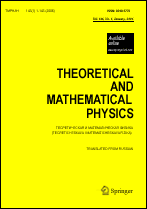|
This article is cited in 6 scientific papers (total in 6 papers)
Yang–Baxter algebra and generation of quantum integrable models
A. Kundu
Saha Institute of Nuclear Physics
Abstract:
We discover an operator-deformed quantum algebra using the quantum
Yang–Baxter equation with the trigonometric $R$-matrix. This novel Hopf
algebra together with its $q\to 1$ limit seems the most general Yang–Baxter
algebra underlying quantum integrable systems. We identify three different
directions for applying this algebra in integrable systems depending on
different sets of values of the deforming operators. Fixed values on
the whole lattice yield subalgebras linked to standard quantum integrable models,
and the associated Lax operators generate and classify them in a unified
way. Variable values yield a new series of quantum integrable inhomogeneous
models. Fixed but different values at different lattice sites can produce
a novel class of integrable hybrid models including integrable
matter–radiation models and quantum field models with defects, in
particular, a new quantum integrable sine-Gordon model with defect.
Keywords:
operator-deformed quantum algebra, unifying scheme for quantum integrable systems, inhomogeneous model, matter–radiation interaction model, sine-Gordon model with defect.
Citation:
A. Kundu, “Yang–Baxter algebra and generation of quantum integrable models”, TMF, 151:3 (2007), 470–485; Theoret. and Math. Phys., 151:3 (2007), 831–842
Linking options:
https://www.mathnet.ru/eng/tmf6060https://doi.org/10.4213/tmf6060 https://www.mathnet.ru/eng/tmf/v151/i3/p470
|


| Statistics & downloads: |
| Abstract page: | 454 | | Full-text PDF : | 240 | | References: | 69 | | First page: | 3 |
|




 Contact us:
Contact us: Terms of Use
Terms of Use
 Registration to the website
Registration to the website Logotypes
Logotypes








 Citation in format
Citation in format 
